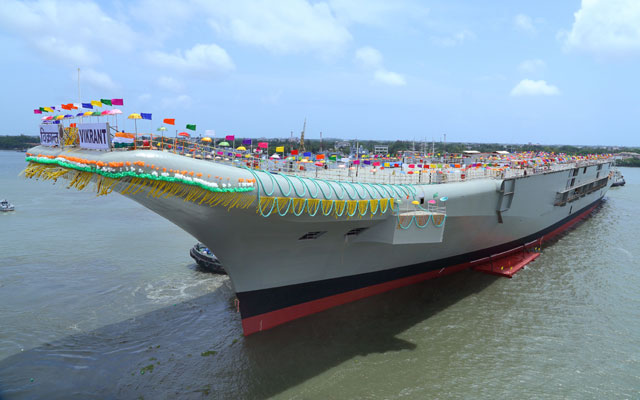India launched its new aircraft carrier last week, the 37,500-ton INS Vikrant. In response, a state-run Chinese newspaper called for more carriers in the People’s Liberation Army Navy fleet. Meanwhile, U.S. carriers—and the entire U.S. Navy—are struggling to meet fleet size requirements due to a chronically underfunded shipbuilding account and broader budget instability.
While the Chinese paper doesn’t view India’s navy as a threat, the author states, “India’s actions remind us that the strategic significance of developing aircraft carriers in Asia is not declining.”
The Chinese article argues that “the strategic deterrence provided by aircraft carriers is still significant.” Yet some U.S. lawmakers clearly disagree. While the U.S. carrier fleet cannot legally fall below 11 ships, this past year some Members of Congress attempted to subvert this requirement by proposing an amendment that would have blocked funding needed to maintain 11 carriers. Since the end of the Cold War, the prevailing strategy to preserve U.S. security and interests has been the ability to conduct two major regional contingencies in different parts of the world simultaneously. Executing this strategy has always required a fleet of at least 11 aircraft carriers. This was not the first attempt to shrink the carrier fleet. Congress reduced the requirement from 12 to 11 only a few years ago. Not long after, some lawmakers were calling for reducing the requirement further to 10 carriers. The Navy currently is using a waiver to the requirement because of a short gap between the most recent decommissioning and when the first Ford-class carrier is scheduled to enter the fleet.
Competition from foreign militaries is not the only reason the U.S. Navy should continue to sail a robust carrier fleet. The air force on board one U.S. carrier matches that of most nations. The ability to sail this power projection force to virtually anywhere in relatively little time has proven effective both for security and political objectives. As former Defense Secretary William Cohen explained, “If you don’t have that forward deployed presence, you have less of a voice, less of an influence.” Carriers also often serve in humanitarian aid missions, with their capacity to supply hundreds of hospital beds, clean water, and auxiliary power in a crisis. U.S. carriers performed these missions during the earthquake disasters in Japan and Haiti, to name just two recent examples.
If this fleet shrinks, it sends a signal to our adversaries that the U.S. will not be able to respond to conflict in every corner of the world. Do we want near peer-competitors such as China filling that void?
The aircraft carrier provides capabilities unparalleled in the fleet and serves the U.S. Navy longer than any other vessel. Its combination of power projection, mobility, and versatility make it a critical element of national security. Members of Congress should reject attempts to reduce this crucial fleet because they have the constitutional responsibility to “provide and maintain a Navy.” America’s position as a global naval power depends on it.






























